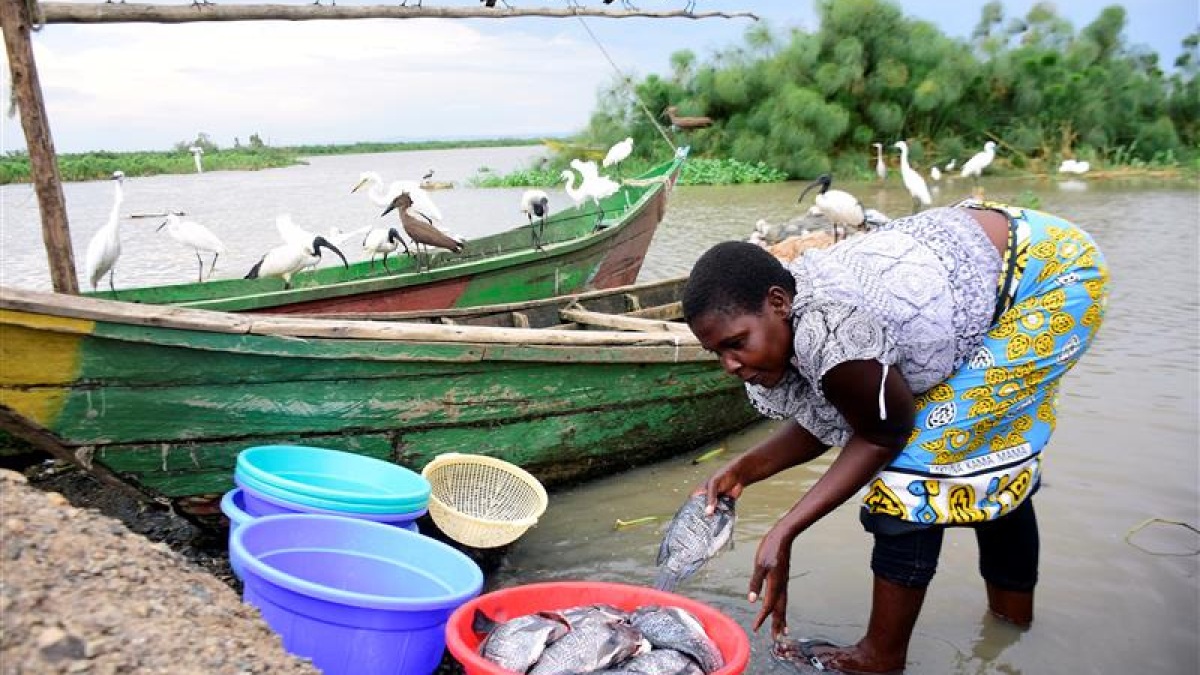[ad_1]
When Elijah Murithi grew bananas within the Eighties and Nineteen Nineties, central Kenya’s more and more erratic climate meant the farmer may not often make a gentle revenue from the thirsty crop.
Extended dry spells killed Murithi’s younger crops, and lengthy, intense wet durations produced a glut of bananas that pressured him to decrease his costs to promote them.
Even when he shifted to espresso, which wants much less water, the farmer nonetheless struggled to supply dependable yields.
However that modified in 2021 when he added an uncommon crop to his farm: fish.
A fishpond full of greater than 1,500 tilapia now permits him to reap rainwater throughout heavy rains and use a few of it to irrigate his crops when dry spells hit, Murithi mentioned.
Now he makes a good dwelling by way of drought or downpours, rising espresso and greens year-round whereas making additional revenue promoting fish.
“This actually labored to my benefit,” he mentioned of his 10-by-25-metre (33-by-82-foot) fishpond, constructed simply uphill from the espresso crops on his 1.25-acre (0.5-hectare) farm in Kibingo, about 130km (80 miles) northeast of Nairobi.
Since he began fish farming in April, Murithi mentioned his espresso harvests have greater than doubled to 2,000kg (4,400 kilos) a 12 months and his total revenue has tripled.
Because the East African nation grapples with local weather swings that batter crops and choke incomes, together with a present drought that’s the worst in 4 many years, some farmers are discovering that including fish to their farms may help with water storage, make their diets extra nutritious and enhance earnings.
Since 2019, the Kirinyaga county authorities has been serving to farmers construct fishponds underneath an financial stimulus programme.
The county covers the price of a pond liner and, for the primary 12 months, pays for child fish, additionally known as fingerlings, and sufficient feed to maintain them till they mature.
The fisheries division mentioned it has up to now supported about 20 farming teams and greater than 1,350 folks.
Kirinyaga’s authorities mentioned in October it was working to extend annual fish manufacturing from 29 tonnes, which has a worth of 12.8 million Kenyan shillings ($104,000), to 62 tonnes. It didn’t present any details about the price of the initiative.
Altering attitudes
At first, most farmers resisted the concept of elevating fish in an usually parched area, mentioned Harrison Mwangi, chairperson of the Kamwaka Self Assist farmers group, which has 26 members.
He mentioned the prospect was alien to lots of the members, who thought they’d have higher outcomes elevating chickens.
However after county officers offered coaching on easy methods to elevate fish and mentioned they’d assist with the prices, many farmers have given it a attempt.
In the end, Mwangi mentioned, his group determined to transform a area of napier grass at a farm owned by certainly one of its members – a area that was producing much less and fewer fodder, particularly through the dry season – right into a fishpond in the beginning of 2021.
Via the remainder of 12 months, the farmers then offered 17,000 shillings ($137) of fish to folks visiting the farm or at native markets, Mwangi mentioned, describing the gross sales as “fairly encouraging” for a primary harvest.
“The group couldn’t have discovered a greater method to utilise the farm,” he mentioned, explaining how farming fish was simpler than managing different livestock.
The Kamwaka farmers, who every have an annual revenue of 100,000 to 150,000 shillings ($807 to $1,211), ought to see even increased earnings from fish farming sooner or later as their shares multiply, Mwangi mentioned.
John Wilson – the supervisor of Mwea Aquaculture Farm, which raises tilapia and catfish and in addition provides coaching to farmers – mentioned fish farming just isn’t solely good enterprise but additionally gives an alternate supply of protein for Kenyans.
A fish surplus
Aside from the problem of persuading drought-hit farmers in Kenya that fish is a practical crop, the challenge nonetheless has a couple of different kinks to work out, Murithi and Mwangi mentioned.
Whereas the ponds could be a buffer towards drought by storing rain for use for irrigation within the dry season, farmers hit with significantly prolonged dry spells can battle to search out methods to high them up.
Murithi mentioned he has at occasions replenished his pond utilizing agricultural water rations offered by the county to assist farmers throughout dry durations.
Kamwaka farmers additionally need to pump clear water from close by rivers to their ponds on a weekly foundation when there isn’t a rain. They use a generator, which is dear to run, Mwangi mentioned.
One other problem is easy methods to take care of a surplus of fish now filling native markets as extra folks take up elevating them, in line with trade insiders.
“Farmers must be aggressive in searching for a marketplace for their produce and shouldn’t anticipate the county authorities to do the advertising for them,” mentioned Michael Manyeki, a fingerling producer in Sagana, a small industrial city in Kirinyaga.
For Ntiba Micheni, a professor of marine and fisheries biology at Nairobi College, the answer to extra manufacturing is getting extra Kenyans to consider fish as dinner in a rustic the place consuming them just isn’t frequent in every single place.
“If there isn’t a sturdy ‘Eat Extra Fish’ marketing campaign for younger youngsters, for colleges and for communities, [selling] fish will perpetually stay a problem,” mentioned Micheni, a former official on the authorities’s fisheries division.
[ad_2]
Source link


